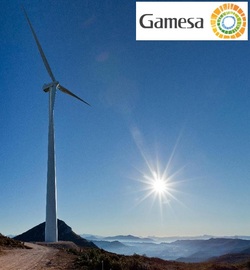Gamesa: Market leader and top wind turbine seller in India
Last year, Gamesa India, the local arm of the Spanish multinational, topped the list of wind turbines sellers in the country.
In an interview with journalists who visited him at the headquarters in Bilbao, Spain, Executive Chairman Ignacio Martin, assisted by Gamesa’s Business CEO, Xavier Exteberria, spoke about what India holds for the company.
Edited excerpts:
- Your Indian management has given you a five-year road map. Can you share the details with us? ... "We are moving very fast. Gamesa is today the market leader in India. With our capabilities in promotion, development, construction of turbines with high local content our position is unique and we can consolidate even further in India. In 2013, our production was around 400 MW and this year, we expect to close at around 700 MW. We hope to have double-digit growth for each of the next five years." While this is about onshore farms, we also have expectations for offshore business in India. We have a fantastic product line-up for offshore. We will continue to invest in the country; we need to develop our supply-chain in India and invest in our manufacturing facilities. In the next five years we would be investing more than €100 million in India.
- Can you be a little more specific on what the Indian management has asked for? ... We need to increase our manufacturing capability within the country, which is the first; second, we need to develop our supply-chain; and third, we need to increase our land bank in order to promote and develop new wind farms. Basically, this means that we need to invest in working capital and fixed assets.
- You have been in India for five years now. Can you list your top three challenges in this period? ... I’ve been running the company for two-and-a-half years only now, so I can list out only what I faced in this period. Initially, the rules were not clear in India; there was also confusion over generation-based incentives. On one hand, the country needed to increase energy generation, but on the other, there were no clear rules to support investment. Second, after the new Government came in, we felt very comfortable with its focus and orientation in order to have the growth that the country needs. The third challenge we faced was the exchange value of the rupee versus the euro and the dollar. The rupee weakness was a matter of concern because we still don’t have 100 per cent local content. Finally, even though the potential is huge, the lack of infrastructure in terms of transmission and distribution lines, roads and general infrastructure in the country is still a question mark.
- Of the four you mentioned, three do not exist now; infrastructure is the only challenge now.... I would say that they are improving; not that they do not exist. There is clarity in regulation but the question mark is how long will the incentives last. Second, different states have different regulations. For example, on the subject of renewable energy certificates, it is not clear if companies do not comply, how will they be penalised. So, things are headed in the right direction, but there’s still work to be done.
- Chinese companies entering India plan to come with financial support for customers who buy their turbines. Do you think it’s a good strategy and would you do something like that? ... Well, we would like to see good financing in India for our business, but it’s clear it does not exist. Our Chinese competitors are indeed backed by their banks. We would like to see support in India in the form of soft loans for wind farms, which is a strategic asset for the country. But offering financial support to our customers is not possible because it is not our business. But we are in a position to find partners who could be interested in going with us into projects.
- What are you doing in terms of developing products tailored to the Indian market? ... We will introduce the next gen G 114 range of machines with longer rotors in the last quarter of 2015 and this will be our key machine for the next three-four years. Additionally, we are planning to increase the height of the towers from the present 93 to 104 metres next year and potentially 110 metres at the same time that we launch the G 114 machines.
- What has been your experience in localising the supply-chain in India? ... The localisation right now is 74 per cent, which is probably the highest among foreign players in India. The plan is to increase this to 85-90 per cent in three-four years. This is part of our strategy to maintain our competitive position and avoid some of the currency issues we’ve faced in the past.
- Which components would you indigenise next? ... We are planning to have more local content in the electrical side of the turbine. Increasing indigenisation is not easy and takes a lot of effort. It will be outstanding if we are able to take it to 85-90 per cent as planned.
(The writer was in Gamesa headquarters in Bilbao, Spain, at the invitation of the company.)
For more information on this article or if you would like to know more about what w3.windfair.net can offer, please do not hesitate to contact Trevor Sievert, online Editorial Journalist at ts@windfair.net
www.windfair.net is the largest international B2B Internet platform – ultimately designed for connecting wind energy enthusiasts and companies across the globe!
- Source:
- Gamesa Eólica
- Author:
- Edited by Trevor Sievert, Online Editorial Journalist / by M Ramesh
- Email:
- info@eolica.gamesa.es
- Link:
- www.gamesacorp.com/...

